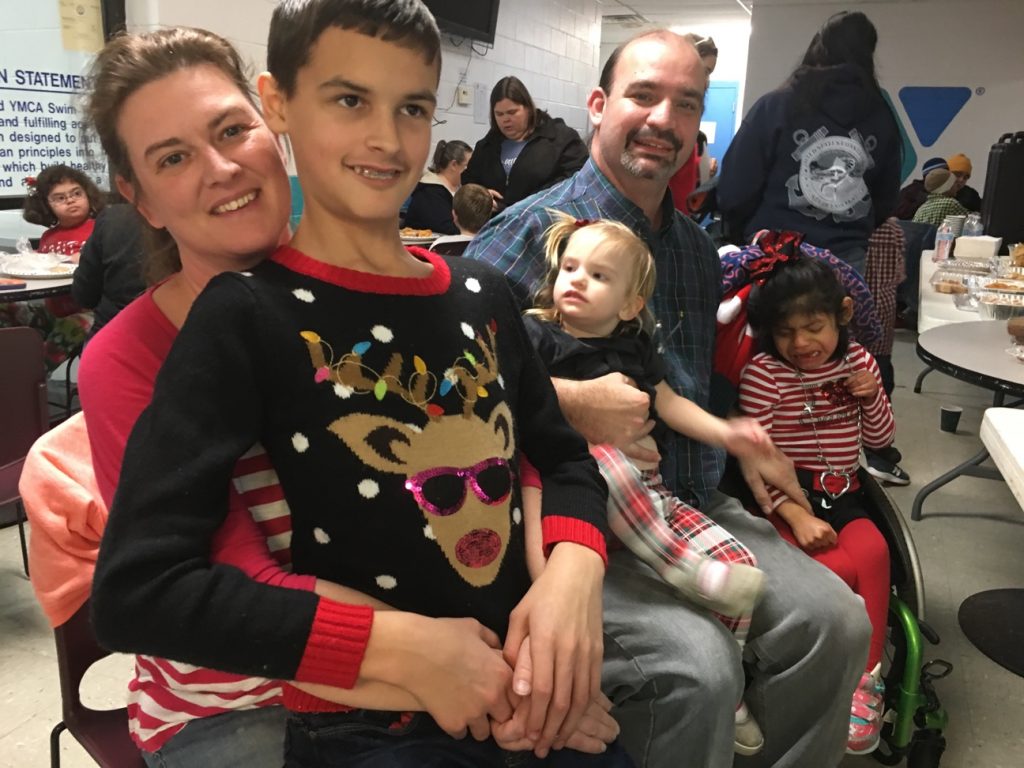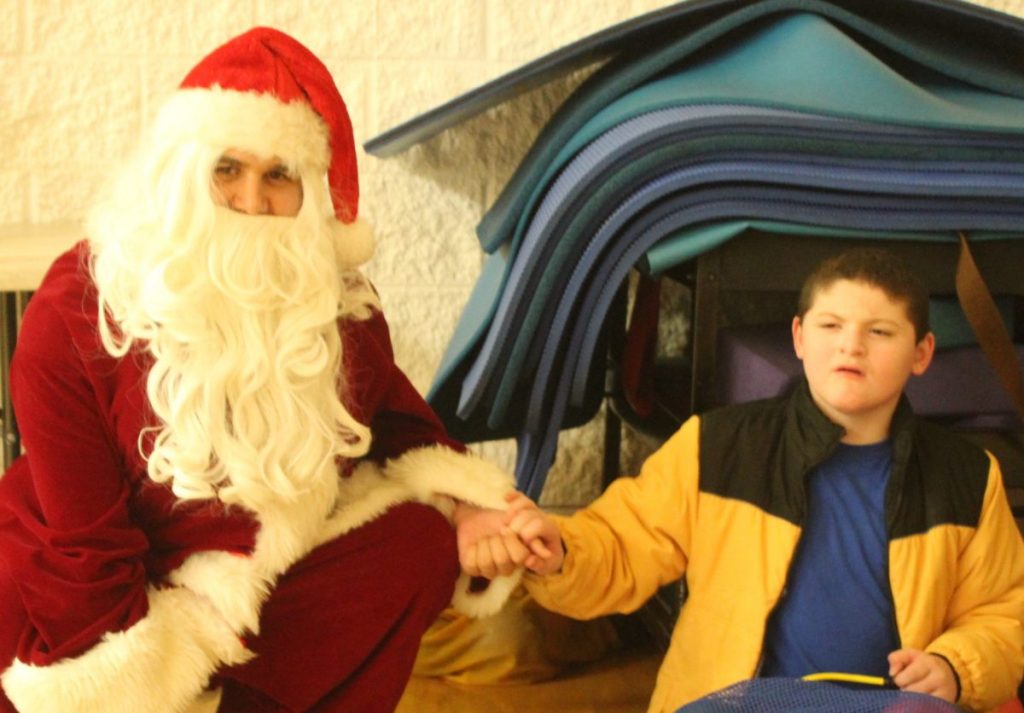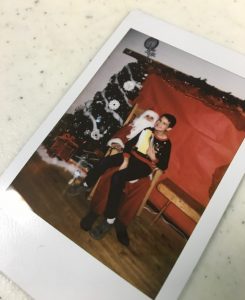News
Sensitive Santa: A Kinder, Gentler Kringle For Kids With Special Needs
By: Mary Meehan | Ohio Valley ReSource
Posted on:
I’m not usually one to name-drop but my brother Pat Meehan is Santa Claus. A real, professional Santa.
Sitting in his home office fresh from work, he’s wearing black suspenders and a red T-shirt. There at least six other Santa outfits in his closet including beach Santa. His thick, white beard (yes, a real one) shimmers faintly with glitter.
It goes without saying that Pat is really into being Santa. He’s been doing it for 40 years.

But even Pat understands how the over-the-top Santa persona can be a bit much. Pat says it’s no wonder kids get rattled. If you think about it, an old, super-extrovert in a crazy outfit isn’t exactly kid-friendly. That can make capturing the traditional holiday photo a trial.
“We tell kids to stay away from strangers then we take kids to see this big, hairy guy in a red suit and we say, ‘Sit on his lap and smile!,’” he said.
Imagine what that’s like for a child who struggles with sensory overload.
Amanda Ralston runs Verbal Behavior Consulting, Inc., where she has worked with children on the autism spectrum and with developmental delays.
The holidays, she said, can be a lot of stress for everyone but for those with sensory challenges it can be extra tough.
“It’s the lights, the smells, the sounds, the endless play of the Mariah Carey songs.”
She said all that, combined with the pressure of meeting a mythical figure, can lead to a lot of stress for both children and their parents. And that can lead to outbursts in an effort to cope with that stress.
It can be so intimidating for parents, she said, they just opt out of the holiday tradition of getting a picture with Santa.
But a growing number of Santa’s helpers are making sure there is an option.
Last year before a holiday party for a group of children with autism spectrum disorder, Pat trained for what’s called a “Low-Sensory Santa.” Sensitive Santa is no less jolly, just more reserved. You move a little slower and let the child take the lead about interacting. And only gentle “ho,ho,hos” allowed, he said.
“It’s important for every child to have that experience to have that feeling of joy and excitement,” he said. “And of course it is as much for the families as it is for the children.”

Welcoming Experience
Social worker Amanda Newsome works at West Virginia University Hospitals Chestnut Ridge Center. She said the staff there saw a need for a more welcoming experience.
“Loud noises, sensitivity to light, waiting in line, we kind of wanted to eliminate that,” she said. “That’s where the idea came from.”
The idea is to give families a chance to experience Santa in their own time and in their own way. That includes activities to keep kids busy as they wait their turn, like making crafts or decorating cookies. Newsome said one child’s visit made a lasting impression.
“We had one girl our first year that would come up and touch Santa and run away, and then come back to come up and try to sit on his lap and then run away again.”
Slowly, eventually, the girl stood next to Santa.
“She never did get on his lap I don’t think,” Newsome said. “It just allows that time, the parents don’t feel pressured, they don’t feel like they have to push their child to hurry up and go because there are other people waiting.”
Zen Santa
Recently in Richmond, Kentucky, large, chains of white paper flakes turned a YMCA workout room into a Zen Santa’s den.
Santa Jared Raymer is a skinny, dark-haired college student wearing a baggy red suit. Sitting on a wooden rocker, not a velvet throne, he greets families brought in by a cheerful, volunteer elf. Most families come to the program through the Kentucky Adaptive PE program at the YMCA.
It is 45 minutes before a child goes directly to Santa. Some ignore him. Some stare from a distance. And then there is Paul Smith.
Paul comes in wearing only one shoe and quickly plops on the floor, fascinated by a bag of soft balls. Raymer majors in occupational therapy at Eastern Kentucky University, so he knows how to handle situations like this. He eases away from his rocker, making a gentle approach. He slowly rolls the boy a ball. Paul, who doesn’t speak, is startled.
“We don’t have to do that,” Santa Raymer says softly.
After that, the two make eye contact and Raymer is soon crouched next to the boy. Then it is Santa who is giggling with joy. As the camera frames that often elusive photo, Paul reaches out to touch Santa’s hand.
“I’m going to tell the elves to bring you lots of presents,” Raymer tells him.

For some parents, a cherished memento can feel like a Christmas miracle.
Veronica and Edward Merritt brought three of their seven children to experience low-sensory Santa. They adopted two of their three youngest, Samantha and Ryan, as

their older children left home. Both Ryan and Samantha have special needs.
Veronica Merritt sighs as she explains trying to navigate the typical mall Santa experience.
“One, they don’t like to wait in line, they don’t like to see something that they can’t get to,” she said. The lines are long, the noise intense.
She’s thrilled to have this option for her kids. “Thank God, it’s about time. It’s nice for us because we feel like we can get out and do what everybody else is doing and we typically can’t do that.”
The event was special she said. The keepsake she retrieves from her purse was something more.
“This is the second time we got a Christmas picture. The first time we went to the mall and there was nobody during the day, we created our own low-sensory Santa,” she said. When she shows off that second Santa picture, the one of her 12-year-old son, she has tears in her eyes.
“Ryan was so excited,” she said, “he was so happy to have his moment with Santa.”

